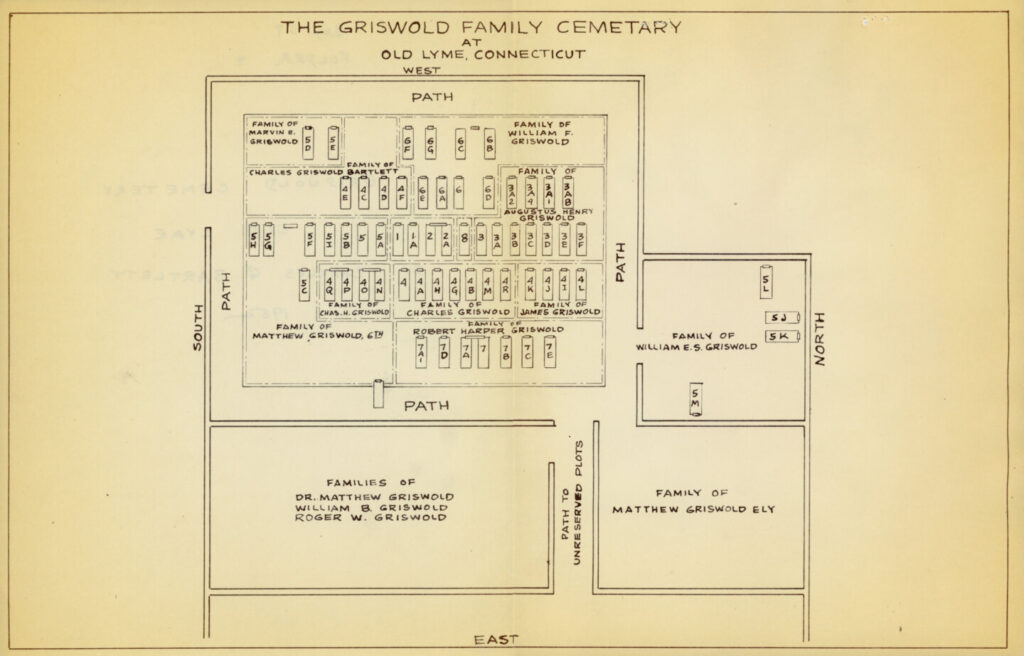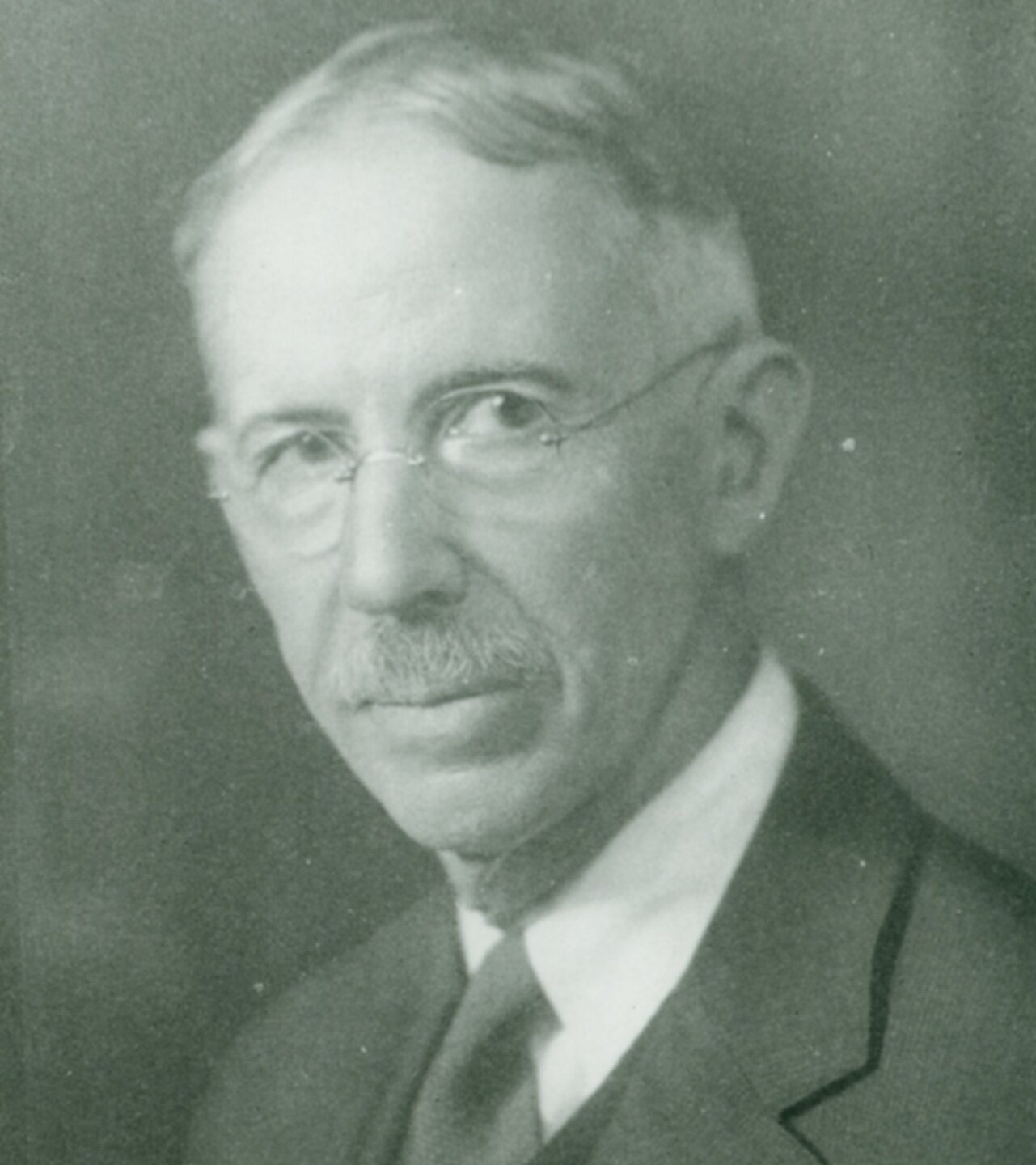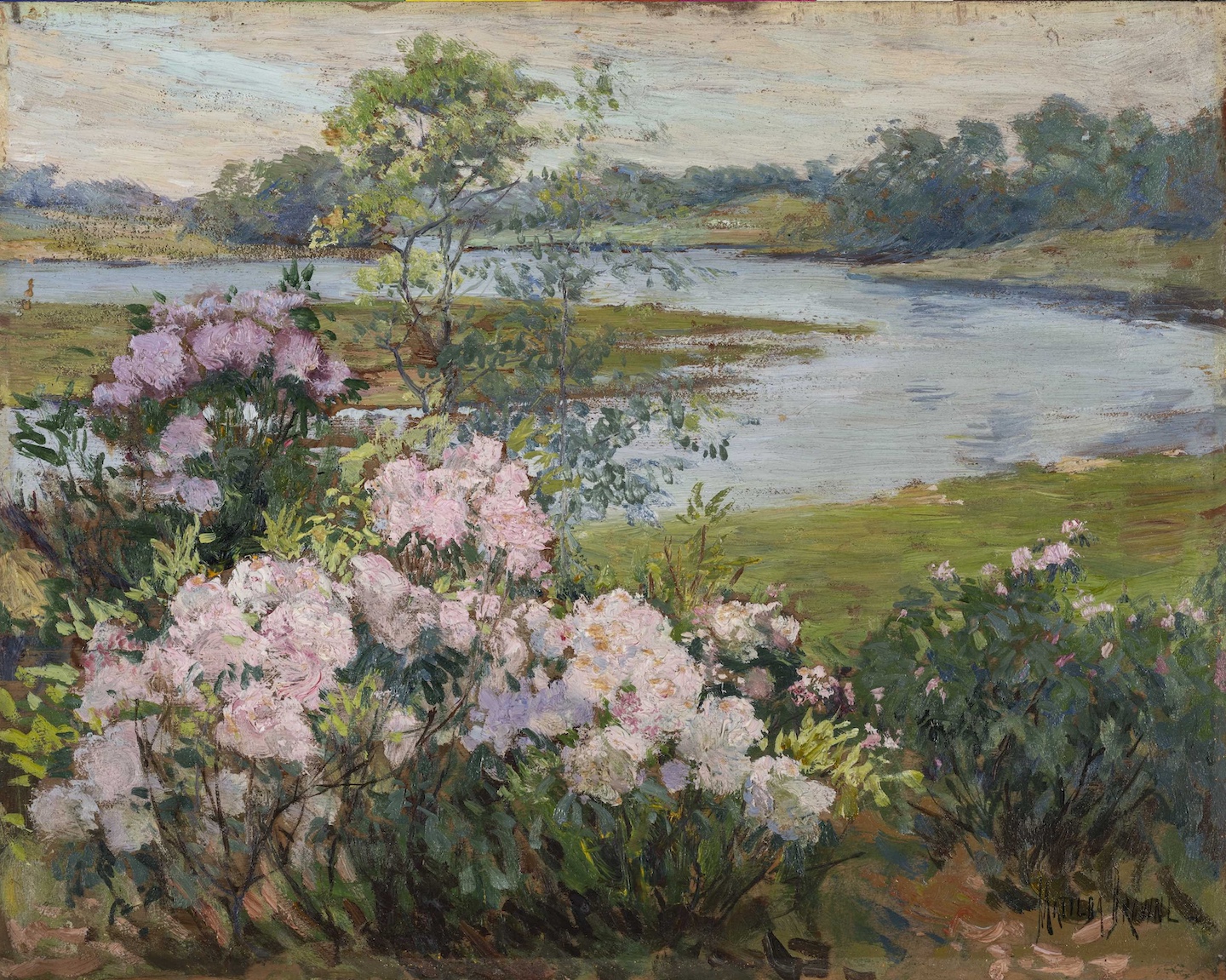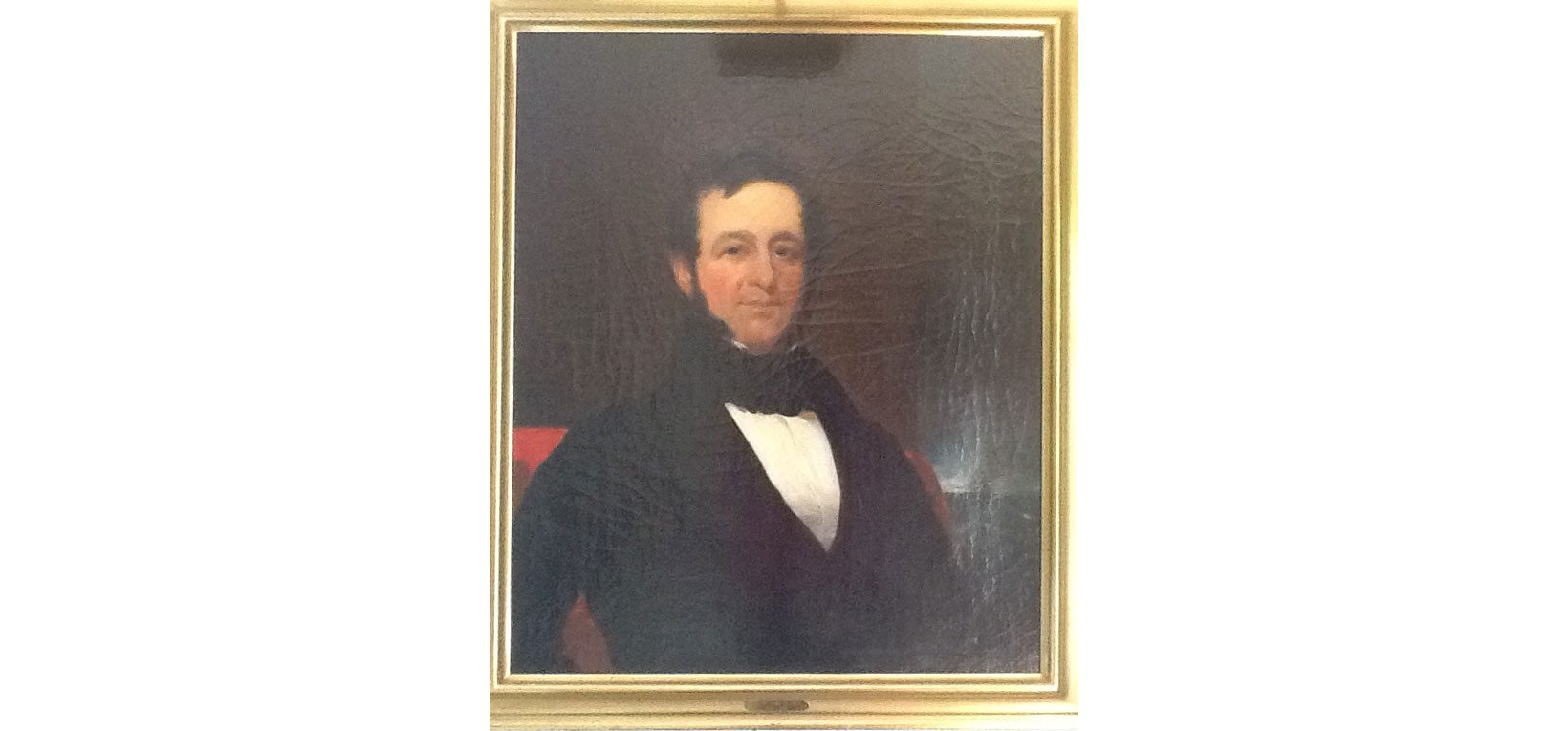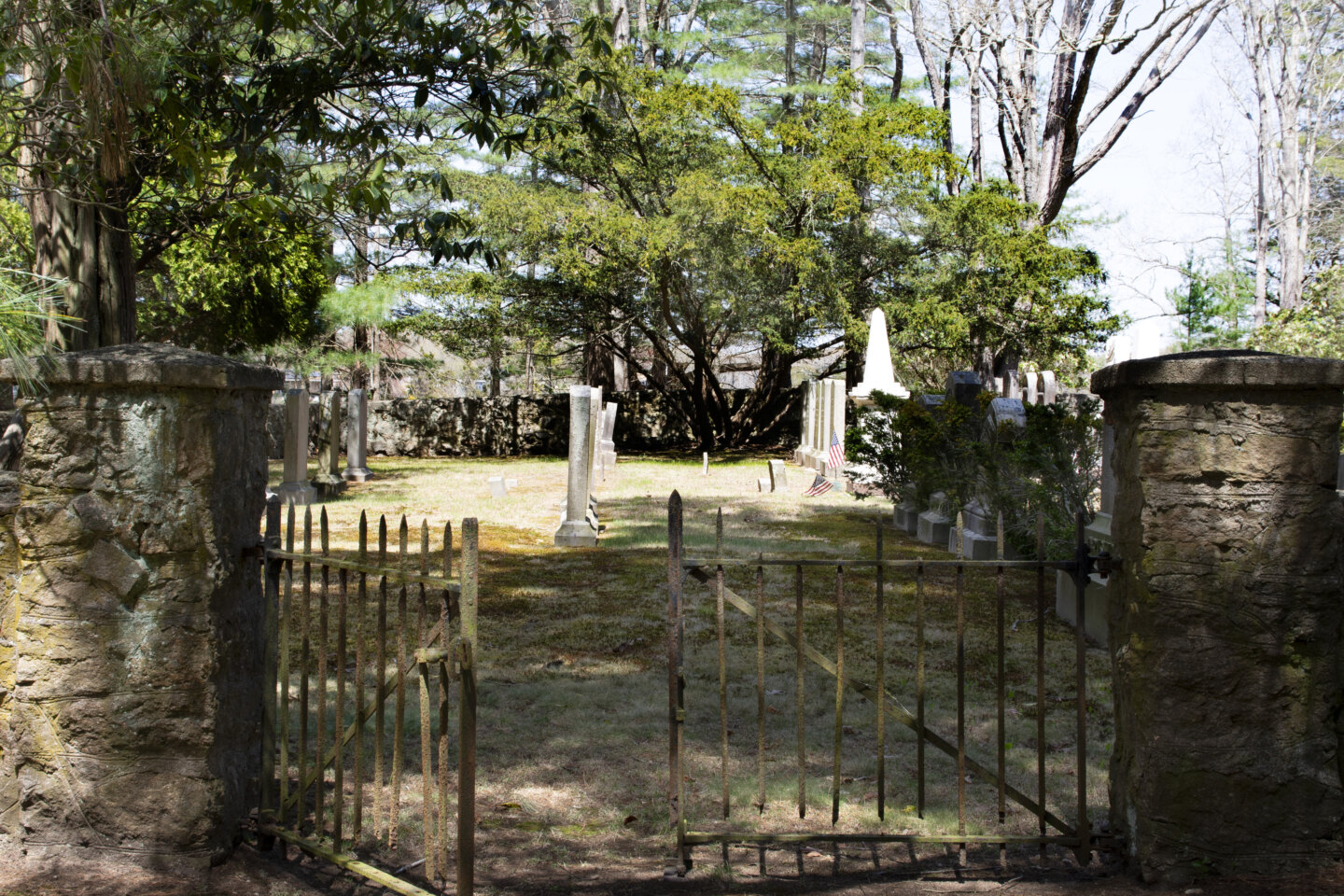
by Carolyn Wakeman
Featured image: Griswold Cemetery, Old Lyme. Photograph courtesy Old Lyme Cemetery Association
Near the rear of a fenced private cemetery on the east bank of the Black Hall River, a graceful monument with traditional urn and willow tree motif marks the Old Lyme burial place of Florence Griswold (1850-1937). The Lyme Art Colony’s founder died of cancer in 1937 at age 86 after a long illness. While the Florence Griswold Museum stands as a monument to the artistic community she fostered, her burial site is far more private. Her marker stands near the gravestones of her parents, grandparents, siblings, and cousins in a now wooded burying ground between the riverbank and Horse Neck Creek.
Florence Griswold’s monument, with incorrect birth year, Griswold Cemetery
Florence Griswold’s obituary, Hartford Courant, December 7, 1937
Florence’s grandfather Governor Roger Griswold (1762-1812) placed the earliest gravestone on what was then an open meadow when his son William died in 1804 at age 19 months. Six years later he commemorated his son James Griswold, who died in 1810 at age one year. [1] A stately obelisk near the children’s gravesites would soon honor the passing of Roger Griswold, Connecticut’s 22nd governor, who died in office in 1812. “He sleeps in the Griswold graveyard,” wrote historian Martha J. Lamb in the 1876 centennial issue of Harper’s magazine, “and his tomb, rising against a background of green, may be seen as you cross Black Hall River.”[2]
 The Griswold Grave-Yard, attributed to Charles Parsons, Harper’s New Monthly Magazine LII (1876)
The Griswold Grave-Yard, attributed to Charles Parsons, Harper’s New Monthly Magazine LII (1876)
Today Governor Roger Griswold’s obelisk, recently cleaned, stands surrounded by monuments to other family members
In 1848 four of Roger Griswold’s sons secured the use of the family graveyard as a future resting place for descendants of Governor Matthew Griswold (1714-1799), whose monument stands in the town’s earliest cemetery at Duck River. Florence’s father Captain Robert H. Griswold (1806-1882) with three of his brothers deeded “one half acre of land situated in the Horse Neck lot so called on the farm owned and occupied by our late uncle Matthew Griswold” (1760-1842) to Lyme’s First Ecclesiastical Society, which administered the affairs of the town’s first parish.[3]

1868 map of Old Lyme, showing Griswold Cemetery in Black Hall
Florence’s father was buried not far from his older brother Captain Augustus Henry Griswold (1789-1836), who also sailed regularly for their cousin John Griswold’s (1783-1856) Black X line of Atlantic packet ships that carried passengers and cargo between New York and London.
Nearby stand gravestones for two other sons of Governor Roger Griswold, Matthew Griswold (1792-1879), who managed the family’s farm and fishery after his father’s death, and Captain William Frederick Griswold (1804-1851), who sailed for two East Lyme cousins, Nathaniel Lynde Griswold (1773-1846) and George Griswold (1777-1859), founders of the prosperous family shipping company N. L. & G. Griswold. William made at least four Pacific crossings as captain of the ship Panama, transporting mixed merchandise to Canton and returning with tea, silks, decorative ceramics, and other commodities.
 Engraved rock commemorating Captain Robert H. Griswold and his wife Helen Powers Griswold, Griswold Cemetery. Photo courtesy Old Lyme Cemetery Association
Engraved rock commemorating Captain Robert H. Griswold and his wife Helen Powers Griswold, Griswold Cemetery. Photo courtesy Old Lyme Cemetery Association
Map of The Griswold Family Cemetery at Old Lyme, Connecticut, Griswold Family Papers, Box 1, folder 59-4 “Griswold Cemetery.” Lyme Historical Society Archives at the Florence Griswold Museum
Other notable family members, including Black X line owner John Griswold and his brother and business partner Charles C. Griswold (1787-1869), were buried in Duck River Cemetery. Near their markers in the Victorian section, a prominent obelisk commemorates merchant Richard Sill Griswold (1809-1847), also Florence’s cousin, who became a partner in the N. L. & G. Griswold shipping firm. Born in New York, Richard graduated from Yale and spent several years managing the family’s business interests in Canton. After marrying in Lyme, he built on today’s Lyme Street a stately brick home, later called Boxwood. Lyme Colony artists, among them Will Howe Foote, William Chadwick, E. Gregory Smith, and Harry Hoffman who served as pall bearers at Florence’s funeral, were also buried at Duck River.
Charles C. Griswold’s monument, Duck River Cemetery, photo courtesy Old Lyme Cemetery Association
Richard Sill Griswold’s monument, Duck River Cemetery, photo courtesy Old Lyme Cemetery Association
 Monument commemorating Lyme Colony artist Harry Hoffman, photo courtesy Old Lyme Cemetery Association
Monument commemorating Lyme Colony artist Harry Hoffman, photo courtesy Old Lyme Cemetery Association
Florence’s wealthy cousins Nathaniel Lynde Griswold, who died in New York in 1846 before she was born, and George Griswold, Richard’s father, who died there in 1859 when she was a child, had established close ties to the city’s business community and chose not to be buried in their native town. Nathaniel rests in an unadorned vault in the New York City Marble Cemetery, but George, more involved in metropolitan social circles, purchased a large plot in the fashionable Green-Wood Cemetery, where his son George C. Griswold (1820-1884) later added an elaborate sepulcher.
New York City Marble Cemetery’s gates
John Frazee, George Griswold III, ca. 1842. Marble. Florence Griswold Museum, Gift of The Hon. Mr. John Davis Lodge, 1976.2.a-d
George C. Griswold’s sepulcher in Green-Wood Cemetery, Brooklyn, New York
In Old Lyme’s Griswold Cemetery the most ornate monument honors Florence’s cousin John Griswold (1837-1862), also a grandson of Governor Roger Griswold. Raised in Black Hall, John graduated from Yale in 1857 and briefly pursued his family’s business interests in the profitable Pacific guano trade, sailing from New London to Honolulu in 1860. He spent six months defending commercial rights to a small guano island before returning home to enlist in the Union Army.[4] Florence was 12 when he died at age 25 from wounds received while leading his company under fire across Antietam Creek. Her father oversaw the selection of a monument to commemorate the heroic young Civil War officer. A letter from the Adams Marble Manufactory in Hartford in January 1865 offered a choice of gravestone styles and costs. The obelisk designed by Thomas Adams bears a poignant inscription: “Tell my mother I died at the head of my company.”
 Letter to Captain Robert Griswold describing options for Captain John Griswold’s monument, January 18, 1865. Griswold Family Papers, Box 2, Lyme Historical Society Archives at the Florence Griswold Museum
Letter to Captain Robert Griswold describing options for Captain John Griswold’s monument, January 18, 1865. Griswold Family Papers, Box 2, Lyme Historical Society Archives at the Florence Griswold Museum
Captain John Griswold’s monument, photo courtesy Old Lyme Cemetery Association
Land surrounding the cemetery passed from Gov. Roger Griswold’s grandson Matthew Griswold (1833-1919) of Erie, PA, to his wife Annie B. Griswold (1845-1936). In 1930 she deeded to the First Ecclesiastical Society a parcel containing 4.95 acres “of upland and salt meadow situated in the Horse Neck Lot, so-called, on the farm now owned by me,” to be used as a Griswold Family Cemetery. After her death three of her sons in 1937 conveyed a five-acre parcel in what was called the “Horse Neck lot” to the Cemetery Association “to be used solely as a cemetery or burying ground forever.[5] Today the secluded Griswold Cemetery remains closed to the public, but land outside the fenced family gravesites may in the future be opened for the burial of other town residents.
Horse Neck Creek
 Old Lyme Cemetery Association map, showing the Griswold and Duck River cemeteries
Old Lyme Cemetery Association map, showing the Griswold and Duck River cemeteries
Special thanks to Amy Kurtz Lansing, John E. Noyes, and Tim Griswold for their contributions.
[1] Griswold Cemetery Records, in Charles R. Hale Collection of Connecticut Cemetery Inscriptions (1934).
[2] Martha J. Lamb, “Lyme: A Chapter in American Genealogy,” in Harper’s New Monthly Magazine LII (1876); reprint Lyme Historical Society (1976), p. 36.
[3] Charles G. Bartlett, “History of Griswold Cemetery” (1952), Griswold Family Papers, Box 1, Lyme Historical Society Archives at the Florence Griswold Museum; Lyme Land Records 33:374.
[4] Obituary Record of Graduates of Yale College (1863), pp. 106-7.
[5] Bartlett, “History of Griswold Cemetery”; Old Lyme Land Records 24:167, 28:398; 36:409.




